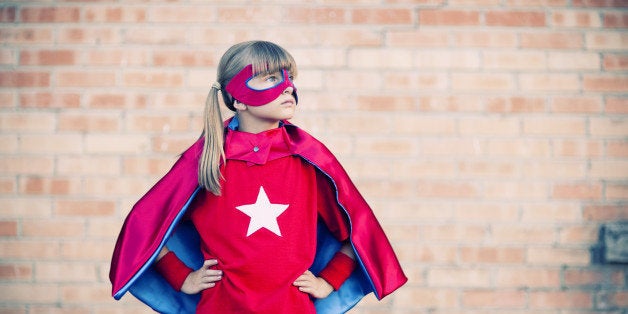
It's no secret that the comic book world is chock full of crime-fighting male superheroes: Iron-Man, Superman, Batman, Spider-Man, Captain America, Wolverine, Professor X, Magneto, The Hulk, The Green Lantern... need we go on? Amid this veritable mass of testosterone, one woman has stood tall, golden lasso in hand, as a bona fide beacon of hope for the arguably fairer but never lesser sex: Wonder Woman.
So it should come as no surprise that women (and men) enthusiastically greeted the recent announcement that Wonder Woman would play a key role in the upcoming Batman vs. Superman film, with a photo released this weekend at Comic-Con. Some praised the undeniably grittier vision of the character -- who will be played by former Miss Israel Gal Gadot -- while others criticized the aesthetic as Xena: Warrior Princess redux.
Still others marveled at what this could mean for modern feminism.
If this sounds silly, it shouldn't. As The Guardian has put it, "Wonder Woman isn't just a feminist icon -- she's the feminist icon." Here's why that statement is far from hyperbolic -- and why we're waiting with baited breath to see if this iteration of the character can live up to its own history.
1941: Wonder Woman Created by Harvard-Educated Proto-Feminist
Wonder Woman wasn't the first female superhero -- Black Widow and Bulletgirl beat her to the game -- but she was the first molded from a distinctly proto-feminist perspective. The character was originated by Harvard-educated psychologist and lawyer William Moulton Marston, whose vision for the character was at once progressive and somewhat gender-reductive. As Marston saw it, female leadership represented the future, since women could counterbalance stereotypically male urges for violence and war. "Frankly, Wonder Woman is psychological propaganda for the new type of woman who should, I believe, rule the world," he wrote in a letter to comics historian Coulton Waugh.
In an interview with Family Circle in 1942, Marston further expressed his desire for a new kind of female icon: "There's great hope for this world. Women will win! When women rule, there won't be any more [war] because the girls won't want to waste time killing men -- I regard that as the greatest no, even more -- as the only hope for permanent peace."
This conception was historically contextualized; at the time, women were entering the workforce in droves as men fought in WWII, prompting early stirrings of the women's rights movement.
1972: Wonder Woman Graces Inaugural Cover of Ms. magazine
In the 1970s, when feminism was coming to the foreground, Gloria Steinem selected the superhero as the cover girl for the very first issue of her new magazine Ms. The depiction was not so much an overt celebration of Wonder Woman as it was a critique of what she had devolved into; after the war ended, and women went back into the home, Wonder Woman became defined less by strength and general bad-a**ery, and more by domesticity and romance.
In total, Wonder Woman would grace the cover of Ms. three times -- including, in 2012, for the magazine's 40th anniversary issue.
Late 1980s: George Perez Crafts a Staunchly Feminist Wonder Woman
In the '80s, comics book legend George Perez, a self-proclaimed "staunch feminist," took over writing Wonder Woman comics, crafting storylines with the help of Steinem herself. His goal? Enable the character to live up to her status as "the sacred icon of feminism." Alas, his tenure overseeing Wonder Woman would last a brief five years
1990s-Present: Wonder Woman Becomes Hypersexualized Balloon-Boobed Bimbo
After Perez stopped writing Wonder Woman, the character fell victim to a larger movement in comic books to craft female characters as hypersexualized conduits for male geek desire. As female comic book writer Trina Robbins has stated, Wonder Woman became one of many female heroes with "balloon breasts and waists so small that if they were real humans they'd break in half." This conception of Wonder Woman has more or less endured into the 21st century, crudely shifting Wonder Woman from an icon of feminism into an icon of male sexual fantasies.
Which is why -- some 75 years since she made her debut -- the film depiction of Wonder Woman is a loaded and significant one. Once again, the Amazonian superhero has been beaten to the punch by Black Widow, who -- embodied by Scarlett Johansson -- has played a secondary role in the blockbuster Avengers films.
In film as in the comic books, the depiction of female superheroes has been fraught with stereotypes, so we're maintaining a healthy level of skepticism that Wonder Woman can -- and will -- fight the good fight for feminism on the silver screen. After all we only have a sexy -- but not offensively sexy -- poster to go from.
We'll just to wait until May 2016 (!) when the movie is released, to find out if any progress has actually been made and Moulton isn't rolling over in his grave. (Again.) In any case, you can bet women will be lining up to watch -- preferably with golden lassoes (and not star-spangled underpants) in hand.
This story first appeared at Ravishly.com, an alternative news+culture women's website.